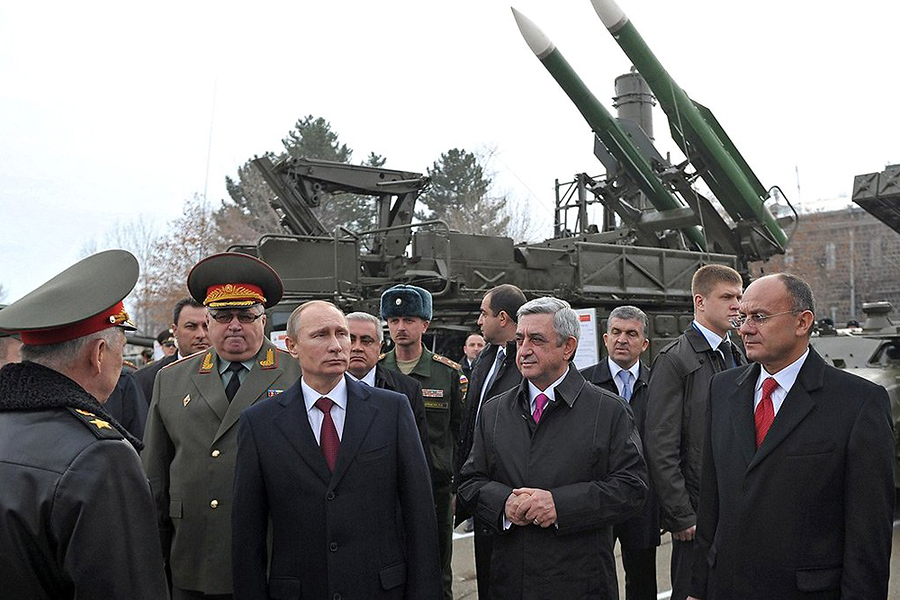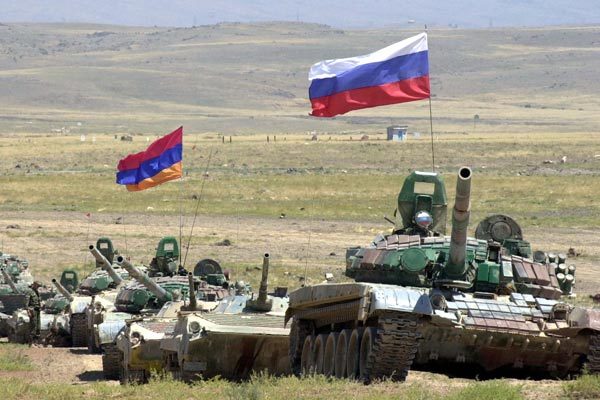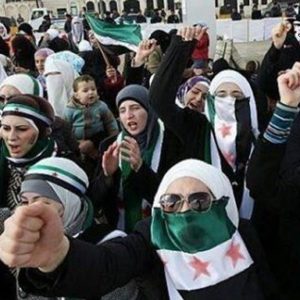Armenia remains in a precarious position. It is dependent on Russia and has nowhere else to turn, but at the same time Russia is supplying arms to Armenia’s arch-enemy Azerbaijan.
In addition, the four-day war in Nagorno-Karabakh in April 2016 clearly exposed the troublesome relations that exist between Armenia and its partners in the Collective Security Treaty Organization (CSTO). The Armenian leadership has realized that it must defend its interests and not only look to Moscow or members of the CSTO.
Armenia’s financial and military resources are severely limited. Moscow offered a loan to Armenia for the procurement of military equipment, but it took longer than a year to materialize. This left many Armenian citizens with a feeling of resentment and distrust towards their strategic partner, Russia.

Russian President Vladimir Putin and Armenian President Serzh Sargsyan (both in center) visit the Russian 102nd military base near Gyumri, Armenia, in early December 2013. The Russian base is less than 10 kilometers from the Turkish border.
The display of Russian Iskander SRBMs at a military parade in Yerevan on 21 September 2016 was intended to deter Azerbaijan, but Baku will move quickly to counter that threat. As a result of the Armenian procurement, the arms race in the volatile South Caucasus is accelerating. Armenia’s defense budget is about USD 450 million and its army is manned almost 50 : 50 with professional soldiers and conscripts. Armenia’s modest Air Force currently consists of 15 Su-25 combat aircraft (including two Su-25 fighter trainer craft) and 12 Mi-24 helicopters. Serviceability and maintenance of the Su-25 have been a problem for the Air Force – a problem that so far remains unaddressed. Russia has two military facilities in Armenia: the 102nd Military Base in Gyumri and the Erebuni Air Force base in Yerevan. The number of troops stationed at the 102nd Military Base is about 3000, with a further 1 000–2 000 at Erebuni. Since late December 2015, Erebuni has been strengthened by 13 Mi-24s and an unspecified number of Mi-8 transport helicopters. In addition, the Erebuni base received 14 MiG-29s in February 2016. Russia furthermore deployed an unspecified number of Tachyon UAVs to Erebuni. Its build-up in Armenia enhances Russia’s ability to project power in the region towards NATO member Turkey as well as towards NATO aspirant Georgia. The downing of a Russian Su-24 bomber by the Turkish Air Force in November 2015 accelerated the process towards achieving a joint regional air-defense system as a part of the strategic partnership between Armenia and Russia. The fact that the aim is a joint rather than unified system means that Air Defense and Air Force units of the Armenian Armed Forces remain independent. Armenia’s then-Minister of Defense, Seyran Ohanyan, and his Russian counterpart, Sergei Shoigu, signed an agreement on 23 December 2015, which was ratified by the Armenian Parliament on 30 June 2016. In order to show Armenia that it is indeed a junior partner in that agreement and that the nature of Russian-Armenian defense relations is decided by Moscow, President Vladimir Putin submitted the agreement to the Russian Parliament only on 7 October 2016. The Russian Parliament has yet to ratify it. Even then, the air-defense agreement will not apply to Nagorno-Karabakh.
Russian and Armenian forces have been jointly protecting Armenia’s airspace since the mid- 1990s. Their integrated air-defense system was given “regional” status by the CSTO in 2007. Therefore, it is not yet clear what additional advantages the 2015 agreement would actually give Armenia in a security sense. Anatoly Tsyganok, head of the Moscow-based Center for Military Forecasts, has asserted that Russia’s motive behind the agreement is to contain NATO, as the Alliance is a threat from the Russian perspective. Armenia and its partners in the CSTO do not share a common agenda on the defense of Armenia in the event of an attack by Azerbaijan. Yerevan has placed its hopes on the CSTO, but in April 2016, at the time of the four-day war in Nagorno-Karabakh, the organization limited itself to calls to end the fighting. It did not support the Armenian position. On the contrary, Kazakhstan released a statement of neutrality, while Belarus declared that the conflict should be resolved on the basis of international legal principles of territorial integrity, creating bewilderment in Yerevan.
The Russian sales of arms to Azerbaijan annoy Armenian President Serzh Sargsyan and his administration. Prime Minister Dmitryi Medvedev further inflamed tensions when, during a visit to Armenia only days after the fighting in Nagorno-Karabakh of April 2016, he reaffirmed Russian plans to continue selling arms to Azerbaijan. Medvedev stressed that this was part of a new policy of Cold War-style deterrence seeking to balance the two sides with Russian weapons. The inability of the Armenian government to pursue an independent policy led to social unrest in late July 2015. What started as a protest against an increase in electricity prices and became known as the “Electric Yerevan” movement turned into a protest against the regime acting submissively and accepting Moscow’s demands.
Indeed, Armenia’s dependence is not restricted to military security. Russia continues to deliver more than 80 percent of the natural gas used by Armenia and is the sole supplier of fuel to the Metsamor nuclear power plant, which produces more than one-third of the country’s electricity. Russia’s Gazprom owns the country’s gas distribution network.
Exports to Russia and direct investments from Russia to Armenia fell in 2015, all this having a negative impact on Armenia’s economic growth. Despite Armenia joining the Russian-led Eurasian Economic Union (EEU) in January 2015, most Armenians are feeling less secure in economic terms today than they did prior to the country joining the EEU. The domestic social unrest has not yet produced changes in the Armenian political leadership. The grip of Russia on Armenia was further tightened by the establishment of a joint Russian-Armenian military unit in November 2016. Neither Russia nor any CSTO partners have ever identified Azerbaijan as a potential threat and that leaves Armenia defending its interests alone.
Eugene Kogan is a Research Associate at the Center for International and European Studies (CIES) at Kadir Has University in Istanbul. He was previously Guest Researcher at the Viennabased International Institute for Liberal Policy. He has written over 70 articles and reports on issues pertaining to hard defense and security and military technologies of Russia and PostSoviet states, Central and Eastern Europe, Israel and China. He has also addressed the issue of Russian-Turkish relations.
Original source: Georgia Today (29/12/2016)







